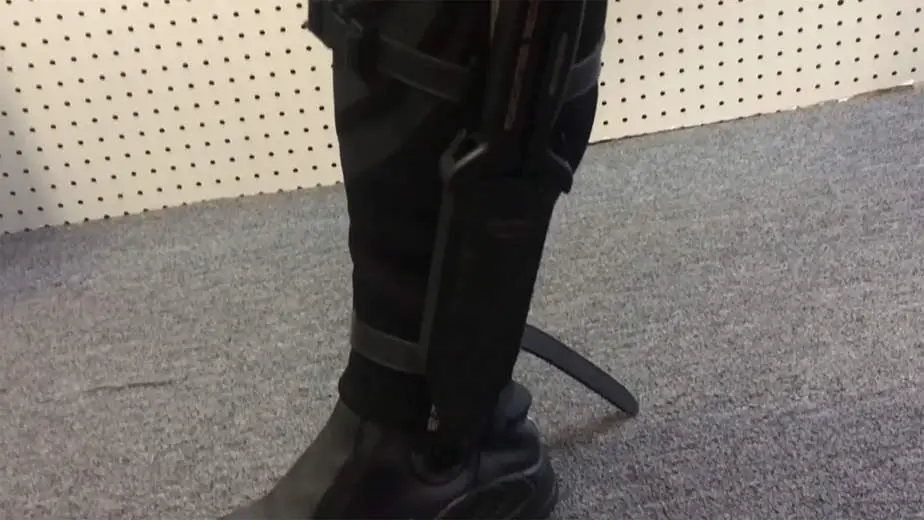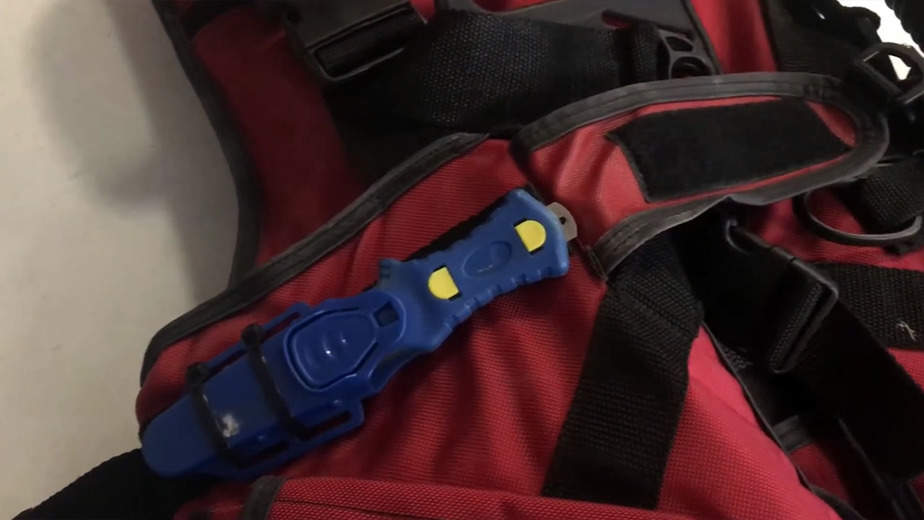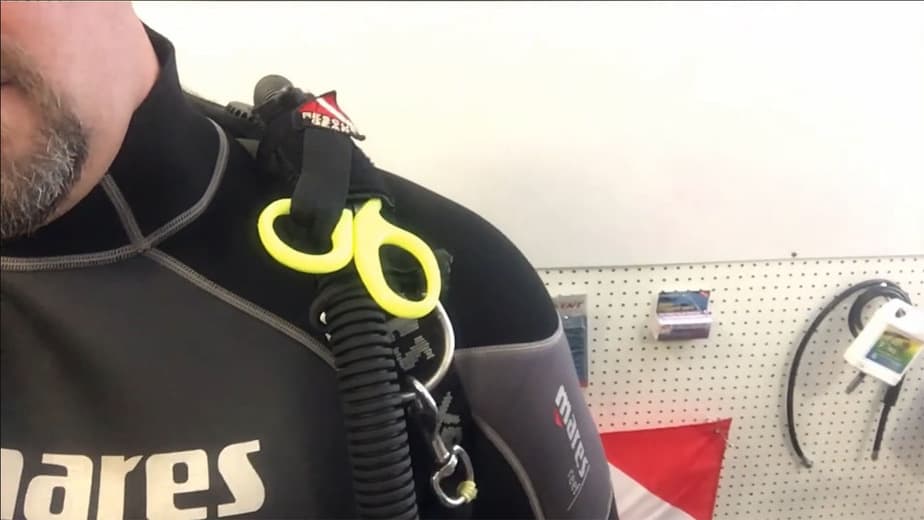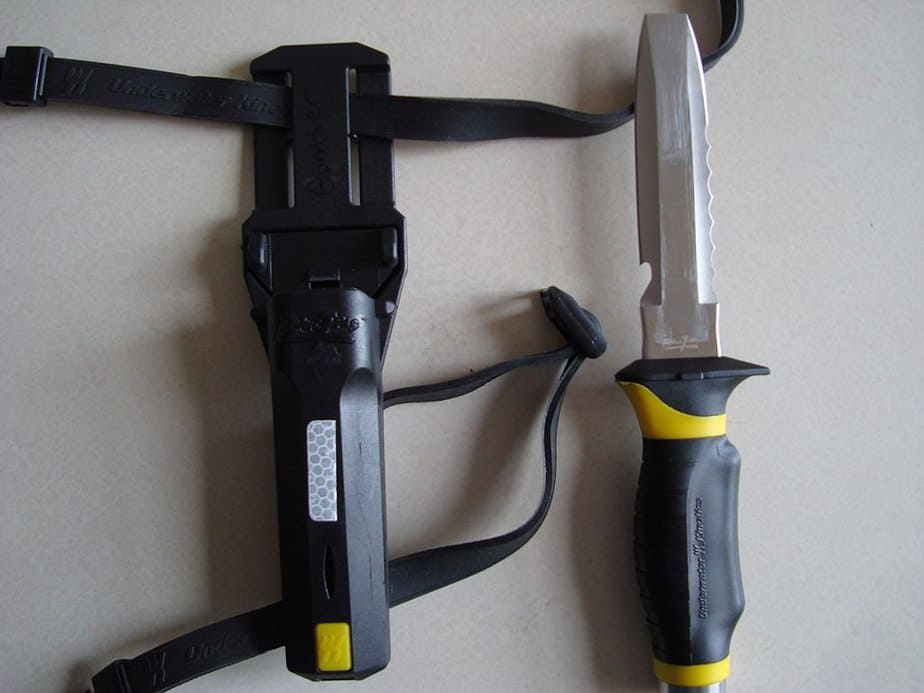You should probably carry a dive knife when scuba diving. It’s one of those things that you’ll probably never need to use, but on the off chance you do, you’ll be glad you had one with you. For instance, if you find yourself entangled in a fishing net or kelp, a knife would be real handy to cut yourself free. And no, not even the best dive knives can be used for protection against large marine life; not even a machete did anything for Quint in Jaws.
One important aspect of a dive knife, other than the qualities of the knife itself, is where to wear a dive knife. We know what it can do for us, but it’s completely useless if you can’t easily reach it and unsheathe it. Also, instead of saving your life, a dive knife can ironically cause injury to yourself if you attach it wrong. The most popular configurations are to attach it to your leg, BCD, or low-pressure inflator .
Additionally, where you attach your dive knife is important so that it doesn’t get caught and does not pierce through your gear or stab you. It should be easily within arm’s reach, and you should have the muscle memory to reach for it and unsheathe it even in low-viz situations. In this article, we’ll discuss the pros and cons of each of the common places where you can wear your dive knife.
Wearing a dive knife on your leg or ankle

Most divers keep their dive knife on their leg, typically around the inside of the ankle/calf. Why here; is it the optimal location? No, it’s just the classic image of a diver and placing it here is based on tradition, not utility. You’ll soon learn that it’s actually not a good place at all to wear your dive knife.
Wearing the dive knife on your leg requires the sheath to be attached to bands which are then fastened somewhere on your leg that you feel is comfortable for you to grab. You can wear it lower or higher on the leg but much of the same issues are present.
The obvious advantage of wearing the dive knife on your leg is that it can run vertically with it, helping you maintain a slim dive profile and keeping the knife out of the way. This is important for keeping drag to a minimum and freeing up your BCD for holding other items.
Unfortunately, the disadvantage of wearing a knife around your leg is that it is a long distance away from your hands. In the event of an entanglement, there would be a delay as you would have to contort your body just to reach your knife, and every second counts in an emergency.
Additionally, let’s say you successfully untangled yourself. To sheathe your knife, you now have to stretch all the way back to return it to its housing. This adds the risk of stabbing yourself if you miss, or failing to engage the locking mechanism if you do not push hard enough (maneuvering can be quite awkward with all of your scuba gear on).
Ironically, mounting the knife on your leg can itself create a snagging hazard. If the knife itself somehow gets tangled up and you can’t unsheathe it, then you must be the unluckiest person in the world.
If you still decide to carry the knife around your leg or ankle, make sure it is on the side opposite your dominant hand. E.g. left leg if you’re right-handed. This makes it easier to reach and unsheathe.
Wearing a dive knife on your BCD

Turns out the leg is actually a sub-optimal location to wear a dive knife; a better location is the BCD.
There should be pockets or attachments on your BCD specifically for dive knives, making it an obvious choice. However, the knife pocket can differ between BCDs, so if you change BCDs often, then you need to retrain your brain to reach for the new location.
Furthermore, not all BCD designs include a knife pocket or attachment. This is not a dealbreaker since you can still store it on your BCD using another pocket or using your own attachment and securing it with Velcro bands or elastic string.
However, if your BCD has a specific dive knife pocket in its design, it’s probably a solid place to wear your knife. The BCD manufacturer should have considered its positioning so that it’s easily within reach and doesn’t cross any tubes where it can get tangled.
Wearing a dive knife on your low-pressure inflator

A very popular place to wear a smaller dive knife is velcroing it to the low-pressure inflator. Due to its close proximity, it’s the easiest place to reach for a dive knife. There’s less chance of struggling to reach into a BCD pocket during an emergency; it’s just right there.
However, despite being easy to reach, it’s not necessarily the safest. Since it’s so close to your face, it can be hard to see so you’ll have to reach for it based on memory and touch. It also makes sheathing extremely tricky so you’ll need some practice. However, once you’ve untangled yourself, you can take all the time in the world to sheathe it safely using two hands.
When wearing a dive knife on the low-pressure inflator, make sure the knife has a blunt tip. This reduces the chances of your knife slashing the low-pressure inflator, which would be disastrous.
Parting words
To sum it up, the three most common places to wear a dive knife are on the leg/ankle, in a BCD pocket or attachment, or attached to the low-pressure inflator. There is no “best” place to wear your knife; each spot has its pros and cons.
The optimal dive knife location is the one you are most comfortable with. Whichever spot you pick, you must practice sheathing and unsheathing it until you can do it with your eyes closed. In the event of a silt-out or dive light malfunction, you should be able to easily take out your knife if necessary.
Even if you never end up using your dive knife, having one with you will give you peace of mind. It’s the same reason why someone might have a second dive computer or mini scuba tank. In the end, there is no right or wrong way to wear a dive knife, just whatever is most convenient for you.

